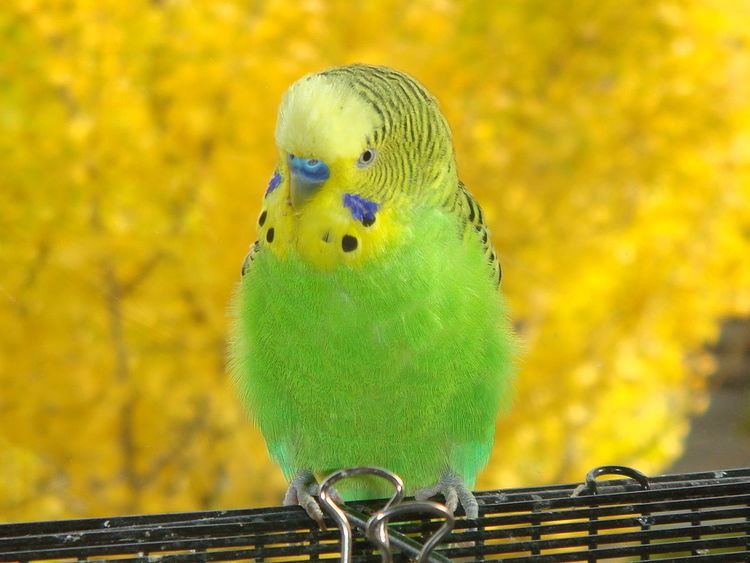 | ||
The Recessive Pied budgerigar mutation is one of approximately 30 mutations affecting the colour of budgerigars. It is the underlying mutation of the Danish Pied variety, aka Harlequin. It is believed by Inte Onsman of MUTAVI to be the same mutation as the Anti-dimorphic Pied (ADM Pied) found in some parrots. The Dark-eyed Clear variety results when the Recessive Pied and Clearflight Pied characters are combined.
Contents
Appearance
All pied budgerigars are characterised by having irregular patches of completely clear feathers appearing anywhere in the body, head or wings. Such patches are devoid of the black melanin pigment and show just the ground colour—yellow in green-series birds and white in blue-series. The remainder of the body is coloured normally. In the Recessive Pied the clear areas are very extensive and many Recessive Pieds are predominantly clear with quite small irregularly shaped areas of normal pigmentation. Although normally coloured, these areas seem to carry a heightened brilliance which is particularly attractive in the stronger colours such as Cobalt, Violet and Dark Green. As with all pieds, there is a large variation in the position and extent of the variegated patches, but the typical striations are almost always present around the eyes. In general, hens are more heavily marked on the wings than cocks.
The eye itself is solid, lacking the white iris ring, and in certain lights a dark reddish plum coloured tint can sometimes be seen, although this is not very obvious. Usually one or several spots are missing, and the cheek patch is usually part violet and part silvery-grey giving it a shimmering appearance. The mask is unaffected, but may appear to be extended downwards if it runs into a clear patch on the body.
In addition to inhibiting the production of melanin pigment in random areas the Recessive Pied mutation also modifies the distribution of the yellow pigment in green-series birds: the intensity of yellow pigmentation in the leading or outermost edge of the wing primaries is enhanced. As this is the only part of the primaries visible in the folded wing the wings appear much yellower than those of the Lutino, which most clearly shows the normal distribution of the yellow pigment. A similar effect in the wing covert feathers imparts a more uniform yellow colouration to the clear parts of the wing, which in consequence entirely lack the ghost markings visible in the Lutino. The long tail feathers are similarly affected, being a deeper yellow than those of the Lutino.
The cere and beak are coloured like the Lutino's. The cere is pale brown in hens and pinkish-grey in cocks. The beak is orange rather than the usual greenish horn colour. The feet are flesh-coloured.
For a description of the Dark-eyed Clear see the Clearflight Pied mutation.
Genetics
The Recessive Pied is an autosomal mutation causing recessive changes which inhibit melanin pigmentation in seemingly random areas over the body. The distribution of melanin pigment is not affected at all—in the pigmented areas the melanin patterns are exactly the same as the patterns in a Normal budgerigar. The mutation does affect the distribution of the yellow pigment, causing it to appear in some areas which are white or greyish in the Normal (see Appearance above).
There is no universally accepted genetic symbol for either the locus or mutant allele, so the simple symbol r+ for 'recessive' will be adopted here for the wild-type allele at this locus, and the symbol r for the Recessive Pied mutant allele, in keeping with the symbol used by Taylor and Warner and Martin.
In its visual effect, the Recessive Pied mutation is recessive to its wild-type allele, so a bird possessing a single Recessive Pied allele (the heterozygote, r+/ r ) is identical in appearance to the wild-type Light Green. That is, the presence of a single wild-type allele is sufficient to permit the full production and normal distribution of the black melanin pigment. Among the budgerigar fancy such a bird is said to be a Light Green split recessive pied, usually written Light Green/recessive pied.
In a bird which has two Recessive Pied alleles (the homozygote, r / r ), the lack of the wild-type allele means that normal black melanin pigment is suppressed in random areas over the body.
The factors governing the distribution of the residual pigmentation are not known.
